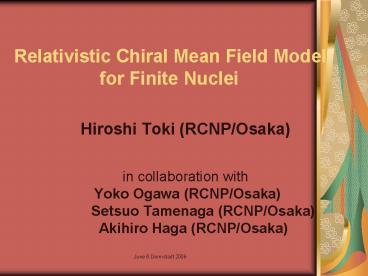Relativistic Chiral Mean Field Model for Finite Nuclei - PowerPoint PPT Presentation
1 / 34
Title:
Relativistic Chiral Mean Field Model for Finite Nuclei
Description:
High resolution GT (pionic) excitations. H. Fujita et al (RCNP) 2003. Tamii for (p, p' ... The masses of sigma and pi mesons become tachyonic. June 8 Darmstadt 2006 ... – PowerPoint PPT presentation
Number of Views:49
Avg rating:3.0/5.0
Title: Relativistic Chiral Mean Field Model for Finite Nuclei
1
Relativistic Chiral Mean Field Model for
Finite Nuclei
- Hiroshi Toki (RCNP/Osaka)
- in collaboration with
- Yoko Ogawa (RCNP/Osaka)
- Setsuo Tamenaga (RCNP/Osaka)
- Akihiro Haga (RCNP/Osaka)
2
Regensburg time (19771980)
3
Physics at Regensburg
- Pion nucleus scattering
- Pion condensation
- Precritical phenomena of pion condensation
- Relativistic mean field model
- Anti-proton physics
- others
4
Pions in nuclei
- We want to work out pion explicitly for the
construction of finite nuclei - We take the Relativistic Mean Field model for
pion with projection of parity and charge - We work out the renormalization of chiral
symmetric model using the Coleman-Weinberg scheme
5
Ab initio calculation of light nuclei
C. Pieper and R. B. Wiringa, Annu. Rev. Nucl.
Part. Sci.51(2001), nucl-th/0103005
6
Resolution Now and Then
Y. Fujita et al., EPJ A 13 (02) 411. H. Fujita
et al., Dr. Th. PRC
7
Experiments
- High resolution GT (pionic) excitations
High resolution (30keV)
H. Fujita et al (RCNP) 2003 Tamii for (p, p)
8
Chiral sigma model
Y. Ogawa et al. PTP (2004)
Pion is the Goldstone boson of chiral symmetry
- Linear Sigma Model Lagrangian
Polar coordinate
Weinberg transformation
9
Non-linear sigma model
Lagrangian
r fp j
10
Mean Field Approximation
Parity mixed self-consistent mean field
Surface pion field
H. Toki, S. Sugimoto, and K. Ikeda, Prog. Theor.
Phys. 108(2002)903
11
Numerical results
Vacuum
9.2
40Ca
56Ni
9.0
N20
N28
Chiral model can make nucleus
8.8
Projection
8.6
8.4
Experiment
8.2
8.0
7.8
90
80
70
60
50
40
30
20
NZ
A (Mass number)
12
56Ni
Magic effect
Parity mixed
Pion produces spin-orbit splitting!!
13
Gamow-Teller transition in Ni56
14
Symmetry projected RMF with pion
15
Parity and charge projection
Parity projection
Kaiser, Fritsch Weise, NPA697 (2002)
0-
0-
Finelli, Kaiser Wretener, Weise NPA770(2006)
16
Charge and parity projected RMF
17
projection -2-
18
Energy components and radius
Y. Ogawa et al., PRC73 (2006) 34301
19
Parity projection
Wave function
20
Density distribution and form factor
21
He4 and He5
Myo et al (2005)
22
Phase shifts for various partial waves
23
Higher partial waves
24
Coleman-Weinberg mechanism forspontaneous chiral
symmetry breakingin the massless chiral sigma
model
- We want to include the vacuum polarization
- for the study of nuclei.
- Nobody have succeeded to work out the
renormalization - for chiral symmetric lagrangian
- We take the Coleman-Weinberg mechanism for
- this program.
25
Chiral sigma model with vacuum polarization
Vacuum polarization
26
Reasons for these problems
1 The number of counterterms is 2 but we need 4
terms
T. D. Lee and M. Margulies, PRD11, 1591, 1975 T.
Matsui and B. D. Serot, Ann. of Phys. 144, 107,
1982
2 Cancellation between nucleon and boson loops
does not occur.
A. D. Jackson et al, NPA407, 495, 1983 E. M.
Nyman and M. Rho, PLB60, 134, 1976
The masses of sigma and pi mesons become
tachyonic.
27
Loop contributions in f4 theory
We define the renormalized potential of boson
loop with counterterms and take two
renormalization conditions for mass and coupling
constant.
for mass
for coupling constant
28
Vacuum loops in the Coleman-Weinberg scheme
S. R. Coleman and E. Weinberg, PRD 7, 1888
(1973)
Renormalization before the chiral symmetry
breaking
29
One-boson loop with chiral symmetry
30
New chirally symmetric renormalization
31
Massless nucleon and boson loops
The differences among boson and fermion loops are
sign and coupling constants, but both of them
have the same functional form.
32
One-loop corrections as origin of SCSB
Input
Output
33
The stable effective potential
Before SCSB
34
Conclusion
- We have developed the relativistic chiral mean
field model for finite nuclei - Spin and charge projection is essential
- Pion provides a half of spin-orbit splitting
- We have succeeded to obtain renormalized chiral
meson-baryon Lagrangian (vacuum effect)































